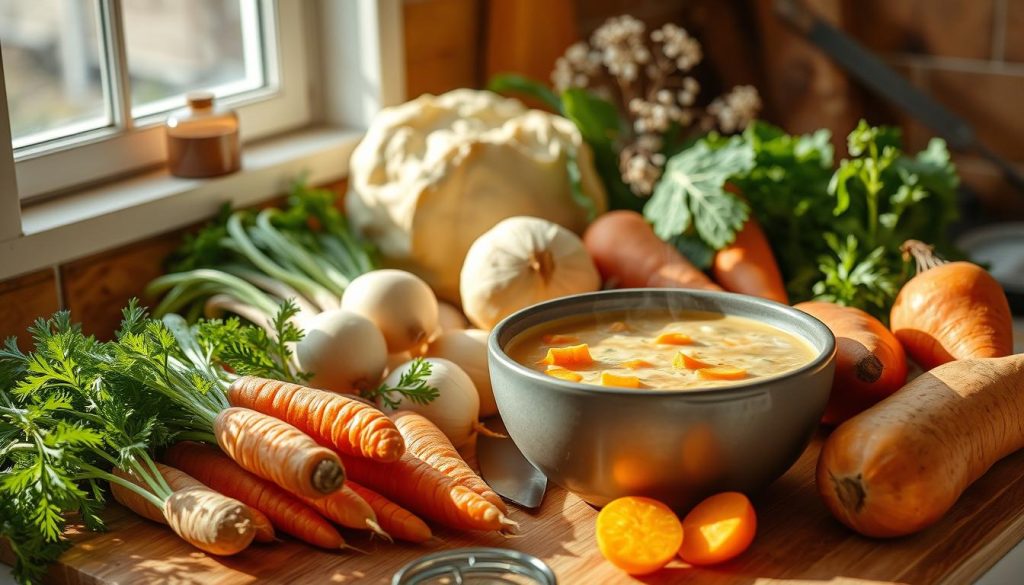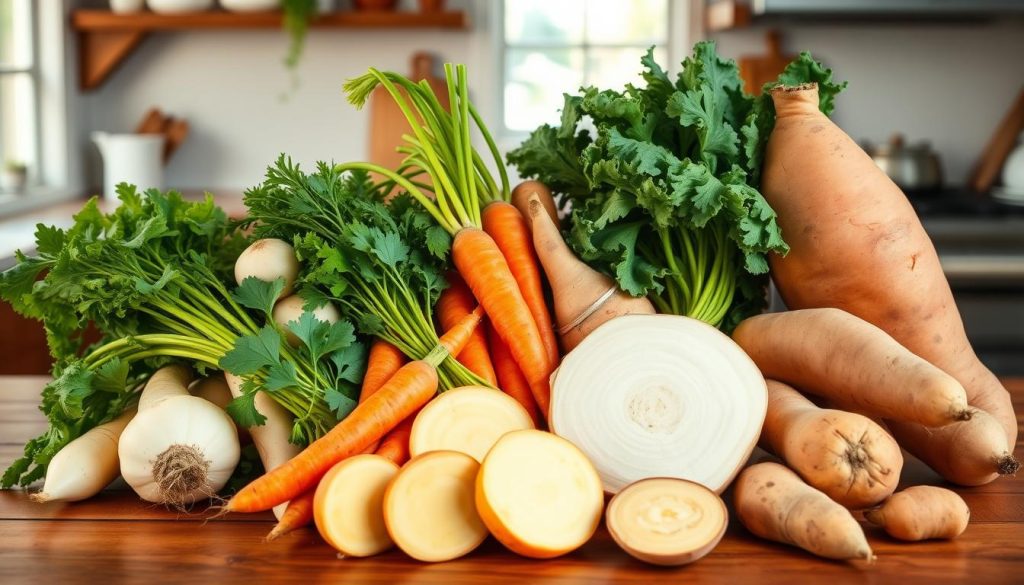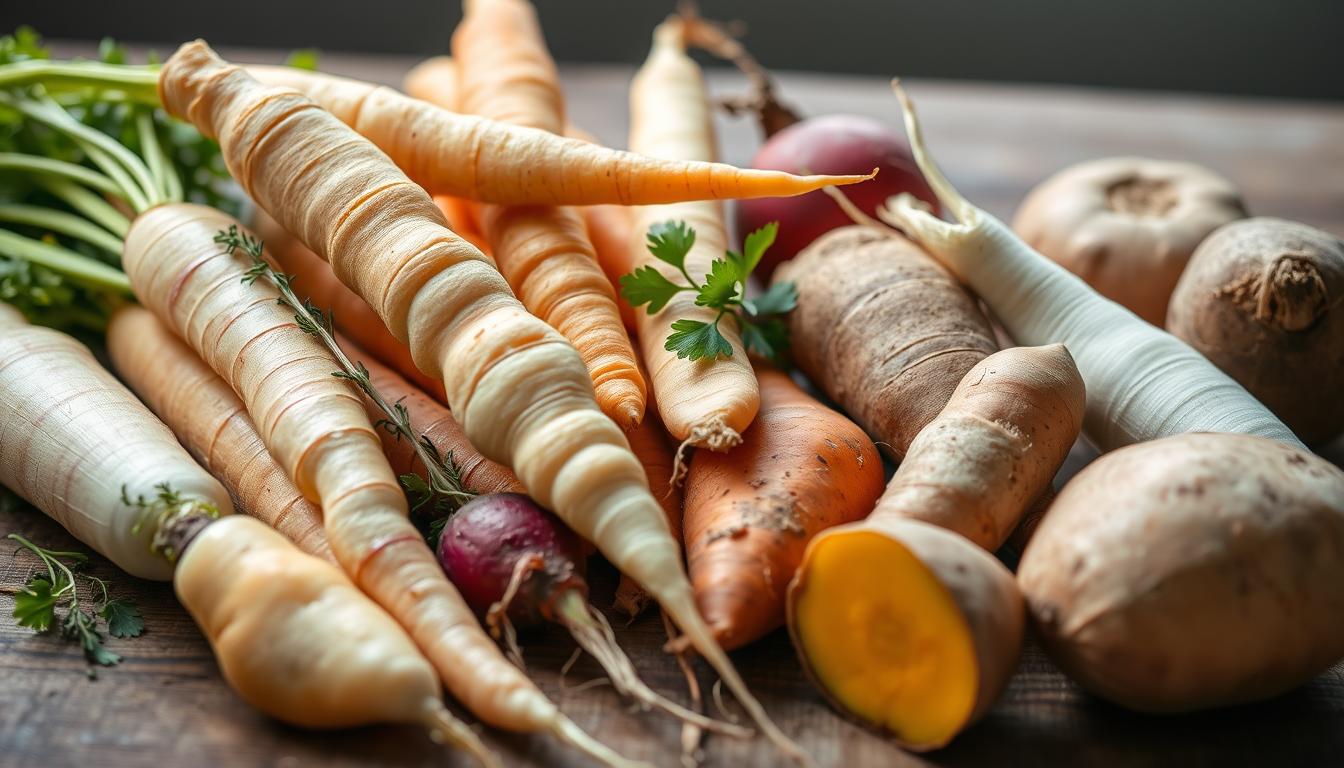Don’t worry if you’re out of parsnips for your recipe. There are many substitutes that keep your dishes tasty and textured. This guide will show you some great root vegetable options. They work just as well as parsnips in soups, stews, or roasted dishes.
Understanding Parsnips: Flavor and Texture
Parsnips are root vegetables, related to carrots and parsley. They have a long, white shape. Their flavor is sweet, earthy, and nutty, especially when cooked.
This makes them great in many dishes, like soups and roasts.
What Are Parsnips?
Parsnips come from Eurasia and have been grown since ancient Roman times. They are sweetest in spring. This sweetness comes from starches turning into sugars during winter.
Before sugarcane was common, Europeans used parsnips as a sweetener. Choose smaller, straight parsnips for better quality. Larger ones might have a tough, fibrous core.
The Nutritional Profile of Parsnips
Parsnips are full of fiber, vitamins, and antioxidants. They have more fiber than turnips, helping with digestion. They are also rich in vitamin K, vitamin C, and folate.
These nutrients make parsnips a healthy choice for meals. Store them unwashed in a cool, dark place for 2 to 3 weeks. Or keep them in the fridge. Pairing them with potatoes and carrots adds unique flavor, especially in autumn and winter.
Why Use a Substitute for Parsnips?
There are many reasons to swap out parsnips in your cooking. Seasonal availability is key; parsnips are best from late fall to early spring. If fresh parsnips are hard to find, look for alternatives that fit your recipe needs.
Bad weather or transport issues can also make parsnips scarce at stores.
When Parsnips Are Unavailable
When parsnips are hard to find, finding substitutes keeps meals tasty. If you’re sensitive to parsnips, pick a different veggie family. Carrots are a great swap, using one to two for every parsnip.
Celery root works too, but you might need to tweak the seasonings. Turnips can also replace parsnips, keeping your dish’s essence intact.
Health Considerations and Dietary Preferences
Health and dietary choices might lead you to swap parsnips. Some people stick to low-carb diets or avoid allergens, making them choose other veggies. If the new veggie tastes less sweet, adjust the seasoning.
Make sure all pieces are the same size for even cooking. Sweet potatoes can be a sweet and tasty parsnip substitute, adding flavor and health benefits to your dish.

Top Parsnip Substitutes: A Handy Guide
Looking for the best parsnip substitutes? You’ll find many root vegetables that can enhance your dishes. Each one has its own flavor and texture, making them great for different recipes. Here are some top options, along with their flavor comparisons and suggested usage ratios.
Carrots: A Sweet and Earthy Alternative
Carrots are a top choice for parsnip substitutes. They have a sweet and earthy taste. You can use 1-2 carrots to replace one parsnip. Their texture is firm yet tender, making them good in soups, stews, and roasted dishes.
Celery Root: Bringing a Celery Flavor
Celery root is great if you want a taste and texture like parsnips. Use it in a one-for-one ratio in recipes. It’s especially good in soups, adding a unique, aromatic flavor.
Rutabagas: A Slightly Sweeter and Nutty Option
Rutabagas are sweeter and nuttier than parsnips. You can substitute one rutabaga for 2-3 parsnips. Their dense texture is perfect for mashing, roasting, or stewing, offering enjoyable flavor comparisons.
Turnips: Adding Peppery Notes
Turnips are perfect for those who like a peppery taste. Use one turnip for every two parsnips. Their firm texture and unique taste make them versatile for many cooking methods, from boiling to roasting.
Sweet Potatoes: Elevating Sweetness in Dishes
Sweet potatoes add sweetness and a creamy texture. A medium-sized sweet potato can replace 2-3 parsnips. They’re great for dishes where you want a richer flavor and smoother consistency.

| Substitute | Amount for One Parsnip | Flavor Profile | Texture |
|---|---|---|---|
| Carrots | 1-2 carrots | Sweet, earthy | Firm yet tender |
| Celery Root | One-for-one | Aromatic, celery-like | Firm |
| Rutabagas | 1 rutabaga for 2-3 parsnips | Sweet, nutty | Dense and firm |
| Turnips | 1 turnip for 2 parsnips | Peppery | Firm |
| Sweet Potatoes | 1 medium for 2-3 parsnips | Sweet | Creamy |
How to Choose the Right Parsnip Substitute
When picking a parsnip substitute, focus on flavor and texture. Each option has its own taste and feel. This can change how your dish turns out. Knowing how it fits with other ingredients and cooking methods is key.
Evaluating Flavor Profiles
It’s important to check the flavor of potential substitutes. Carrots taste sweet, similar to parsnips, making them a favorite. Sweet potatoes add sweetness, matching parsnips well. Turnips have a peppery taste. Salsify, with its oyster-like flavor, adds a unique twist to meals.
Assessing Texture and Cooking Methods
The texture of your substitute matters a lot. Carrots work well as a direct substitute and stay firm when roasted. But, celery root and rutabaga need different cooking times, affecting your dish. Knowing your cooking method is crucial. For example, sweet potatoes make creamy soups smooth, while turnips and salsify add heartiness to stews.
| Substitute | Flavor Profile | Texture | Recommended Cooking Method |
|---|---|---|---|
| Carrots | Sweet | Firm | Roasting, Steaming |
| Sweet Potatoes | Sweet, Earthy | Soft | Mashed, Soups |
| Turnips | Peppery | Crisp | Stews, Roasting |
| Celery Root | Vegetal | Firm | Soups, Purees |
| Salsify | Oyster-like | Firm | Soups, Stir-Frys |
Conclusion
Exploring different options can really boost your cooking skills. Ingredients like carrots, rutabagas, and salsify can replace parsnips well. They add unique flavors and textures to your dishes.
Understanding the nutritional values and cooking methods of these substitutes is key. This way, your meals will be tasty and fulfilling.
When choosing substitutes, match them to your dish’s needs. Each option has its own taste, letting you get creative in the kitchen. This approach ensures your dishes turn out great, even with ingredient swaps.
Finally, variety is crucial for making your cooking better. Try out different veggies to find the perfect mix for you. This way, you’ll enjoy delicious meals and get health benefits too. With a bit of creativity, cooking can be incredibly rewarding!
Source Links
- https://www.gurneys.com/blogs/blog-post/rutabagas-turnips-and-parsnips-so-theyre-good-for-me-but-do-they-taste-good?srsltid=AfmBOooMJXgZpWYfogqUmENBESOG6iNwSeZMxVb8Y_AIOnp5wMQztr_q
- https://www.howmuchisin.com/produce_converters/parsnip
- https://www.firsttunnels.co.uk/page/TopOfTheCrops-Parsnip
- https://www.allrecipes.com/article/what-is-a-parsnip/
- https://www.thespruceeats.com/all-about-parsnips-4115576
- https://www.alsothecrumbsplease.com/parsnip-substitute/
- https://shepherdexpress.com/food/flash-in-the-pan/parsnip-power/
- https://www.easychickpeasy.com/best-parsnip-substitutes/
- https://www.handycookbook.com/what-is-the-best-parsnip-substitute/
- https://thestonesoup.com/blog/2020/01/17/vegetable-substitutes/
- https://discover.texasrealfood.com/swap-and-savor/parsnip-substitutes
- https://theeatdown.com/parsnips-substitute/
- https://www.thespruceeats.com/parsnip-storage-and-selection-1807788
- https://discover.texasrealfood.com/swap-and-savor/how-to-substitute-parsley-root-for-parsnips
- https://discover.texasrealfood.com/swap-and-savor/how-to-substitute-salsify-for-parsnips
